
|
Apr 14, 2009
Peter Foster: An Inconvenient Film
By Peter Foster, The National Post
Gore is about to feature in a new movie, but he’s not going to like it very much. Titled Not Evil Just Wrong: The True Cost of Global Warming Hysteria, the film presents a devastating account of the shaky foundations and hefty price of Mr. Gore’s brand of self-interested and hypocritical alarmism. Created by the Irish film making duo of Phelim McAleer and Ann McElhinney -who made another excellent documentary about the “dark side of environmentalism” called Mine Your Own Business - Not Evil provides the perfect rebuttal to Mr. Gore’s An Inconvenient Truth.
Despite being chock-a-block with inaccuracies and misrepresentations, Mr. Gore’s movie has frightened schoolchildren all over the world, driven the public policy debate, and garnered both an Academy Award and a Nobel Peace Prize for its star. Not Evil - which is due to be released later this year - will appear at a crucial time. The world’s crisis-beset nations are due to meet in Copenhagen in November to concoct a new policy straitjacket to succeed the meddlesome but utterly failed Kyoto Accord. If global warming’s U.N.-based ringmasters have their way, this will lead to a slashing of industrial production in developed countries and to a huge extension of boondoggle redistributionist schemes to fund “green” technologies in developing countries.
Alternating credible skeptics with arresting imagery, the film makes clear that the science, far from being settled, has been comprehensively misrepresented by the likes of NASA’s James Hansen, who is to Al Gore and climatology what Trofim Lysenko was to Joseph Stalin and agronomy.
There is a wonderful scene of Mr. Hansen becoming almost discombobulated at the very mention of Stephen McIntyre, the maverick Canadian who, with the help of Guelph economist Ross McKitrick, took on the UN climate change establishment over the so-called “hockey stick” temperature graph, and won. Mr. Hansen claims that paying attention to such inconvenient truths amounts to just “clouding the issue”
The film dramatically outlines the dreadful damage already done by environmental hysteria, in particular the millions of unnecessary deaths caused by the campaign against DDT. That campaign started with Rachel Carson’s Silent Spring, which was at the root of the modern environmental movement in every sense. Despite the World Health Organization’s lifting of the DDT ban, Al Gore remains devoted to Ms. Carson’s memory. And methods. As Patrick Moore, one of the founders of Greenpeace but now a skeptic, points out, radical environmentalists “care more about fish eggs than they do about children.” Meanwhile kids are shown fretting about about imminent global inundation and the deaths of polar bears.
Just as Mine Your Own Business showed how opposition to mining in developing countries comes often not from the “grassroots” but from well-funded multinational NGOs with as little concern for local employment as they have for truth, so Not Evil Just Wrong further demonstrates environmentalists’ disregard for humanity, and in particular the poor.
Perhaps the most memorable scene in Mine Your Own Business was that of the WWF’s local representative in Madagascar, Mark Fenn, who was leading opposition to a development by Rio Tinto. The appalling Mr. Fenn, who owned a $35,000 catamaran and was building a local luxury home, claimed that poor people were happier, and that if the locals had more money they would “just spend it.” The film makers have come up with similar buffoons for their new movie, including a Bible-thumping environmentalist in Uganda who opposes using DDT and claims that the U.S. never experienced malaria and Hollywood actor Ed Begley, who suggests that Fijians are “happy with nothing.”
Not Evil Just Wrong which will be released later this year - is an important film that deserves the widest possible distribution, both in theatres and schools. The only quibble that I have with it is that its title might be too generous to those it exposes. To find out more about the movie and the fundraising campaign to help its distribution visit its website.
Apr 14, 2009
Gore’s Current Media Pulls IPO, Citing Poor Conditions
By John Letzing, MarketWatch
SAN FRANCISCO (MarketWatch) - Current Media Inc., the television and Internet firm co-founded by Al Gore with the intention of “democratizing media,” has shelved plans for an initial public offering of its stock. San Francisco-based Current said in a public filing on Friday that it has requested the withdrawal of an IPO registration statement initially filed in January of 2008.
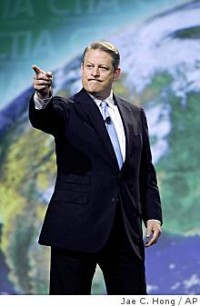
“In light of current market conditions, the registrant has determined not to proceed at this time with the public offering,” the filing read. In its IPO registration filing, updated in May of last year, “participatory media company” Current said its revenue is derived from affiliate fees from the likes of Comcast Corp. (CMCSA) , while a much smaller portion comes from advertising fees from firms including General Electric Co.
According to the registration filing, Current had $17 million in revenue and a net loss of $5.7 million for the three months ended in March, 2008, and was available in roughly 56 million subscriber households. The company also said it intended to use proceeds of the IPO to help repay $43 million in debt and for general purposes.
Current launched Current TV in 2005, and also operates Current.com. The company is focused on younger viewers while relying heavily on so-called “user-generated” content contributed by non-staff reporters. “We believe there is a significant gap between what is being delivered by traditional sources of TV and what is demanded by young adults,” Current said in its IPO registration filing. Former Vice President Gore serves as Current’s chairman and board director, while other directors have included supermarket magnate Ronald Burkle and former MTV Networks President Mark Rosenthal.
See this story here. Current recently made headlines when two of its staff journalists were detained by North Korean guards while working near the Chinese border. North Korean media has reported that the reporters are expected to stand trial for “hostile acts.” See story on that here.
Apr 12, 2009
Global warming endangers U.S. corn production, study says. WRONG!
By Jim Tankersley
Global warming could rob the U.S. economy of $1.4 billion a year in lost corn production alone, a national environmental group estimated in a report released Thursday. The Environment America study, based on government and university data, projects that warming temperatures will reduce yields of the nation’s biggest crop by 3% in the Midwest and the South compared with projected yields without further global warming.Iowa would be hit hardest, losing $259 million a year in corn revenues, followed by Illinois at $243 million. California, which leads the country in agriculture but doesn’t grow much corn, would take an estimated $4.7-million hit.
The study doesn’t directly address other crops, but one of its main sources, a 2008 government report on the effects of warming on agriculture and natural resources, suggests that California’s signature fruit and vegetable harvests could suffer even more than corn if temperatures rise. “Corn likes it cool, but global warming is raising temperatures across the nation,” said report author Timothy Telleen-Lawton in a news release. “Hotter fields will mean lower yields for corn, and eventually, the rest of agriculture.”
Telleen-Lawton said the estimates of revenue loss were tied to expected increases in temperature and carbon dioxide levels that could be reached within the next few decades if steps were not taken quickly to cut the amount of greenhouse gases emitted into the atmosphere. The report is a direct challenge to other studies, often cited by critics of government efforts to curb greenhouse gas emissions, that project moderate warming would increase crop yields.
Higher carbon dioxide levels would help plants grow, Princeton University physicist William Happer, a critic of emissions limits, told a Senate committee this year. “Crop yields will continue to increase as CO2 levels go up,” he said in submitted testimony, “since we are far from the optimum levels for plant growth.” Icecap Note: this is supported by NASA satellite monitoring which shows a ”greening of middle latitudes”, an increase in yields of 30% and 10% more acreage in the last 50 years due in large part to higher CO2. More vigorous plants are also more drought resistant. This has enabled us to feed more of the world’s people.
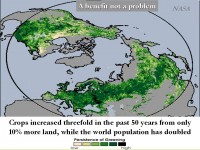
The report by Environment America, an environmental advocacy group, contends that damaging effects from warming would far outweigh a carbon-fueled yield boost. “Not all the effects of global warming will be bad for agriculture; growing seasons will be longer, and increased carbon dioxide levels encourage plant growth,” the report says.
“But global warming will make some of the challenges that agriculture faces significantly worse, including increasing temperatures, more damaging storms, ozone pollution, and spreading pests, weeds, and diseases.” The report doesn’t attempt to quantify losses from storms, floods, insects and ozone pollution related to global warming. It calculates damages based on warming temperatures, which could rise above corn’s optimum growing range of 64 to 72 degrees Fahrenheit during the growing season. It also says farmers can help fight global warming—and the government can encourage their efforts—in part by turning some of their land into wind and solar energy farms.
But the report stays silent on the fate of perhaps the most touted—and politically controversial—intersection of U.S. agriculture and global warming: corn ethanol, which proponents call a path away from fossil fuels but which critics say could cause as much global warming harm as good. See story here.
Icecap Note: Iowa was mentioned as being vulnerable to more heat. Actual Des Moines, Iowa data says otherwise. Out of the 61 record highs for June and July, 33 occurred in the 1930s, 5 in 1988 and NONE since.
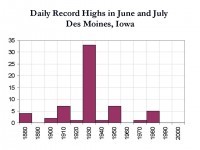
See larger image here.
Most of the warming globally has been in urban areas, in winter and at night. None of these apply to farmland. Also temperatures globally have been on the decline in the last 7 years. Agricultural areas tend to have elevated nighttime readings and lower daytime temperatures due to enhanced moisture due to evapotranspiration (see Christy study here).
Apr 12, 2009
Atlantic dynamo turned up the heat over Medieval Europe
April 3, 2009, PhysOrg.com
In the April 3rd edition of Science a collaborative group of scientists from Switzerland, California and the UK report that medieval climate over Europe was heated by the North Atlantic Oscillation (NAO). This oscillation pattern, defined as the pressure difference between the Icelandic Low and the Azores High, also influences modern-day weather conditions and has contributed to the recent droughts in North Africa and floods in North-Central Europe.
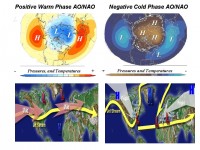
A comparison of tree rings from 1000-year old trees in Morocco and growth layers in a stalagmite from a cave in Scotland now reveal the mechanism behind the “Medieval climate anomaly” - a period of global warmth between 1000 and 1400 AD. During this period, the pressure difference between the Azores High and the Icelandic Low was large and, by driving warm Atlantic winds over the cold European continent in winter time, was heating the European mainland (bottom left in diagram).
Trees and stalagmites are “proxy archives”, meaning that they are natural data sources from which past climatic conditions can be derived. Old cedar trees from the Atlas Mountains in Morocco grew extremely slowly during Medieval Times and thus reflect much drier conditions during this period compared to following centuries. These dry conditions, in turn, are an indicator for a strong Azores High. Opposite to the African tree rings, the Scottish stalagmite shows that during the same period it was much wetter than normal in northern Europe, reflecting a strong Icelandic Low.
Scientists from the Dendro Sciences Unit at the Swiss Federal Research Institute have teamed up with experts from the USA and the UK, including Royal Society-Leverhulme Trust Senior Research Fellow Professor James Scourse of the School of Ocean Sciences at Bangor University, to compile and to develop the first NAO reconstruction to extend back to the Middle Ages. By comparing these proxy archives to modelled climate simulations they were able to analyse temperature, precipitation, and wind conditions across Europe over the last millennium and to test the reliability of their results. Comparisons with other terrestrial and marine proxy archives from across the globe suggest that the changes seen in the NAO are part of a global reorganization of the ocean-atmosphere system.
Valerie Trouet, first author of this study, points out that “the modern-day effects of the NAO are relatively small and short-lived compared to those during the Middle Ages”. This study demonstrates that climate has undergone large changes long before humans started releasing large amounts of greenhouse gases into the atmosphere, indicating that natural forcings should be taken into account when trying to understand the climate of the future. See Climate Audit’s issues with the study and the conclusions of Mann etal that it confirms the Medieval Warm Period as a regional phenomenon focused on Europe. CO2 Science has shown the MWP to be truely global in nature supported by data published by 690 individual scientists from 404 separate research institutions in 40 different countries here.
Apr 12, 2009
“Catlin Team in Peril?
By Harold Ambler
The three-person team of British explorers on the Arctic ice cap may or may not be in danger, depending upon which of the team’s representatives back at headquarters in London is doing the talking. Martin Hartley, Pen Hadow, and Ann Daniels have been on a “scientific” mission to measure sea ice thickness that is routinely measured by satellite and buoys. Unfortunately, just about all of their equipment failed as soon as the team got onto the ice, due to what the BBC has reported as unexpected wind chill values as low as minus 70 degrees Celsius.
On the health front, according to Catlin Arctic Survey medical adviser Doctor Martin Rhodes, the team are battling chronic hypothermia. Additionally, Martin Hartley has frostbite on one foot, photographs of which are on the mission website, with a disclaimer for the faint of heart. On the other hand, according to Catlin communications director Rod Macrae, all is well. “They’re fine,” he said, in a phone interview Thursday. “There is no hypothermia.” Macrae maintained that people with agendas that he didn’t even want to speculate about were looking to criticize the team, when, actually everything is going very well indeed. “Pen [the team leader] has said, “Were stuck in the tent, and we’re unable to take any measurements.” And people have rushed to all sorts of hasty conclusions about their situation being dire or something.”
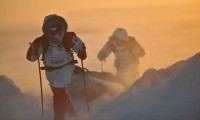
Pen Hadow and Martin Hartley of the Catlin Arctic Survey battle the elements in the name of science, and their own survival
And yet, according to a blog entry on the Catlin website by support team member Gaby Dean, the team members do not sound normal when they phone in each day, their words slurred and muddled. Macrae was surprised to learn that the team’s “live” biotelemetry (heart rate, breaths per minute, core temperature, and skin temperature) had been repeating for upwards of a week (closer to a month, it turned out). Hadow’s core temperature reading of 33 degrees Celsius (91 degrees Fahrenheit), day after day, had given plenty of the people following the mission pause, if not a sense of foreboding. As for the slurred speech, Macrae explained that when the facial muscles get cold, they do not perform normally.
“All clothing can do is slow down the process of losing heat,” Doctor Rhodes said. “The only way they can keep the hypothermia at bay is to keep moving and to keep eating.” Although the team is equipped with the highest-tech cold-weather gear that money can buy, many have questioned the decision not to use traditional seal and animal fur gear, considered by some experts to be superior in the extreme environment.
As of the end of the day on Thursday, which was a rest day, the team had progressed 245 kilometers. Their goal is to take ice measurements all the way to the north pole, but with only 40 days left before they will be removed from the ice, their pace will have to quicken in order for them to attain their goal. They have 678 kilometers still to travel. The pilots who have brought the team two resupplies are the same ones who will pick them up at the end of the expedition, and they have stated that they are unwilling to risk their aircraft and personal safety on the increasingly questionable ice after May 25, according to Macrae.
“To be honest, reaching the pole is entirely secondary to capturing the scientific data,” Macrae said. When asked whether any sea ice data (live streaming data had been promised prior to the expedition) could be made available, Macrae explained that Catlin had decided to hold off on that for the time being. “We will be putting some data up onto the website, when we think it’s substantial enough to provide something of interest.”
He was pointed in denying that any discussion of removing the team from the ice had taken place. “No, never,” he said. “I think there has been a fairly serious misinterpretation of the situation.” When informed later in the day that the team’s own medical adviser had diagnosed them, albeit remotely, with chronic hypothermia, Macrae responded with an e-mail: “What has been said and is, as you I am sure aware pretty obvious, they are constantly battling hypothermia.” Read more here.
Read also What if the Catlin Arctic Ice Survey is for Naught on Watts Up With That.
|
|
|
|







